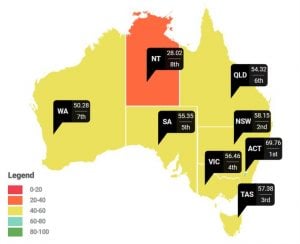Beyond the economy: why social progress should be measured Health and Wellbeing
Beyond the economy: why social progress should be measured
A guest post from Megan Weier at the Centre for Social Impact.
When governments talk about ‘progress’, it’s almost always in economic terms.
In these terms, Australia has had an unprecedented period of progress, with 28 years of economic growth. But we argue that economic progress is only one indicator of a society’s success.
Increasingly, we’re seeing both politicians and the public call for new ways of thinking about budgets and the economy. The traction that New Zealand’s ‘wellbeing budget’ has gained (and the resistance it has received from some members of parliament) indicates that Australians want new ways of talking about progress. VCOSS has similarly urged the Victorian Government to shift to a wellbeing economy that prioritises achieving social outcomes, not only tracking economic progress.
We know that economic indicators alone don’t tell us what life is like for people living in Australia. We cannot assume that simply because Gross Domestic Product (GDP) is going up, so is the wellbeing of a society. The mining boom is a stark example – while it has contributed to strong economic development for Australia, it has also had devastating impacts on the environment and communities where mining took place.
As anyone who has worked in advocacy knows, it can be hard to argue for change without some form of data to support the argument. Economic measures are readily accessible – GDP, unemployment rates and household spending are all used as indicators of how economically progressive a society is.
What we need, then, are ways of showing how socially progressive a society is, based on its ability to meet human needs and create foundations for wellbeing and opportunity.
Over the last 14 months, our team at the Centre for Social Impact have been working with the Social Progress Imperative in developing Australia’s first Social Progress Index (SPI) as part of the Amplify Social Impact project. The Index has been calculated at a global level since 2013, but this is the first time that we can see where there are unique successes and challenges across Australia’s states and territories.
What does the Social Progress Index measure?
The Social Progress Index defines social progress as “the capacity of a society to meet the basic human needs of its citizens, establish the building blocks that allow citizens and communities to enhance and sustain the quality of their lives, and create the conditions for all individuals to reach their full potential.” It works by collecting indicators that contribute to components of social progress, with the aim of answering what we call ‘universally important questions’. For example:
- Personal safety: Do people feel safe?
- Health and wellness: Do people live long and healthy lives?
- Personal freedom and choice: Are people free to make their own choices?
Finding data that could appropriately represent these components was no easy task – which may explain why we tend to rely on economic dollar values as indicators of progress, rather than trying to gauge how people are experiencing life within a society. We consulted with academics, not-for-profit and peak body representatives, industry, and local and national government departments to get a sense of what a ‘wishlist’ of socially progressive indicators would be, and set out to see what data was available.
We ended up with 52 indicators that made up the Index, including estimated homelessness rate, the rate of people who experienced physical assault in the last 12 months, and the proportion of people who agree that the police “treat people fairly and equally”. (You can see the full methodology, including the final indicators and their data sources, here.)
This process led us to this insight into how Australian states and territories ranked (scores and rankings are available for exploration on our website), relative to one another, in overall social progress in 2018.

It should be noted that the SPI is an indicator of how socially progressive the state or territory’s policies and societies are – not the individuals who live there. However, with such stark disparities in scores between the Northern Territory and other states and territories, we can see that the way policy and programs are being delivered in the Northern Territory is simply not working.
Australian states and territories generally did well on foundational concepts such as access to nutrition and basic medical care, but scored lower on social equity indicators such as access to information and communication, and personal freedom and choice. It is not enough to focus only on basic human needs – for overall social progress to improve, all components of the SPI must increase.
Putting the Index to use – and improving it over time
We want the SPI to be a useful tool for those in the not-for-profit and for-purpose sector to advocate and elevate their causes. Most people can find their cause represented somewhere in the Index, even if their specific indicator wasn’t able to be included. We hope it can be a tool that can be used to advocate for funding or political attention.
How can the SPI help decision-making? We’re planning on taking the SPI results on the road, visiting state and territory governments to talk through the SPI results to understand where there is success in policy, but also where there are specific areas that require targeted help.
We need to shift away from an economy-focused view of growth, and instead look towards inclusive growth that prioritises the wellbeing and opportunity of communities and the people who live in them. The Australian Social Progress Index is one way to help amplify this call.
Dr Megan Weier is a Research Fellow at the Centre for Social Impact.